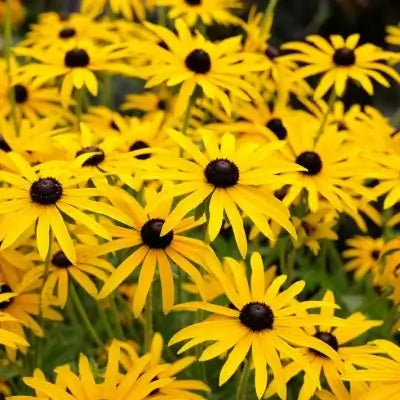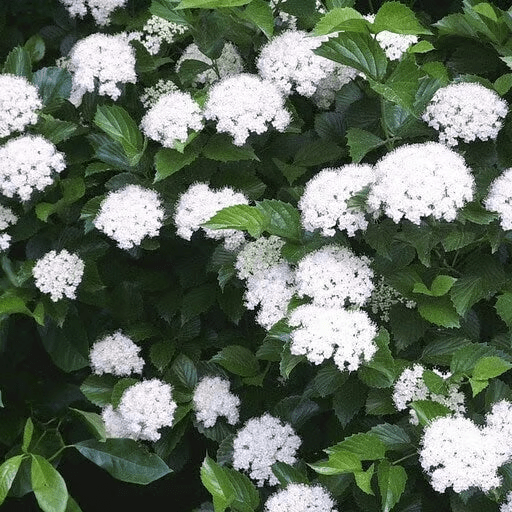
Perennials
Attractive year-round foliage and blooms
Versatile for various garden settings
Tolerates a range of soil conditions
Thrives in
ZONE 3ZONE 4ZONE 5ZONE 6ZONE 7ZONE 8Planting Season:
Nov-AprilWhen you add one plant to cart, it automatically adds the second one free on Bogo deals.
Viburnum dentatum is a deciduous shrub native to North America. It features attractive clusters of white flowers, vibrant blue-black berries, and toothed leaves, making it a versatile and popular choice for hedges and wildlife gardens.
It earned its name because the inhabitants of the areas where it grew used the branches to create arrows in past centuries. The deciduous shrub's straight branches made it an ideal choice for that purpose.
The shrubs produce small clusters of white flowers about 4 inches wide, which start appearing in the spring. They also produce small fruits as the summer progresses. Although they can expand as tall as 15 feet, they often stand under 10 feet in height. Their impressive size makes them a great shrub for hedgerows. Many people plant arrowwood shrubs individually in their yards or gardens. However, they are also popular choices to adorn the shores of creeks or ponds.
This rounded shrub has a graceful, elegant appearance. The branches and twigs have a grayish-brown color and are slender. With their ridges, they add a touch of rustic appeal. Greenish-brown buds create a contrast that commands attention. Its white flowers are delicate and look stunning against its colorful leaves. The toothed edges of the leaves give the plant its name. Although they start with a green hue, they gradually turn yellow and red as the seasons change. During the summer, the bluish-black fruits add even more beauty. For anyone who enjoys a colorful landscape, this type of shrub does not disappoint.
In addition to its aesthetic benefits, there may be health benefits for some. It is also an excellent choice for people who want to attract wildlife. Several songbirds enjoy the fruit, and some animals eat the twigs and leaves. Since the flowers have nectar, they are helpful to bees. Butterflies are also attracted to the flowers. It is an excellent example of nature's profound beauty and ability to change. It is a great choice for anyone because of its ecological, aesthetic, and other potential benefits.
What is the common name for it?
Another name for it is Arrowwood. This is because native Americans used them to make arrows.
Where do they grow best?
It does best in draining soils, in full sun to partial shade. It's fairly drought-tolerant, but it's a clay, sandy, and loam tolerant plant in USDA hardiness zones three to eight.
Can you grow them from cuttings?
Indeed, Viburnum Dentatum can be propagated from softwood cuttings taken during the early summer. This will work most effectively if done by placing the cuttings in rooting hormone before placing them in soil that has moderate moisture content and good drainage.
What pairs well with it?
They look good with perennials and ornamental grasses or annuals such as coneflowers and black-eyed Susans. It also does well as an underplanting for smaller shrubs or in wildlife gardens.
Which fertilizer should I use on it?
The recommended fertilizer is a slow-release fertilizer with a neutral NPK balance of 10-10-10. Apply to plants in the first weeks of spring to keep them healthy.

Bloom Season
Spring
Bloom/Foliage Color
White
Height at Maturity
Over 10 Feet
Care
Viburnum dentatum thrives in well-drained soil and benefits from regular watering to moisten the soil. Trim after blooming to preserve shape and remove dead or damaged branches. Fertilize annually with a balanced fertilizer for optimal growth and blooming.
Plant Reproduction
Viburnum dentatum spreads via suckers and seeds, forming dense clusters
Plant bare-root shrubs during the more excellent spring or fall months, from November through April. Dig a hole twice as wide as the root system and slightly more profound than its height. Position the shrub so that the top of the roots is level with the ground, and put back the soil dug over the roots. Apply a 2-3 inch layer of mulch around the base to retain moisture and suppress weeds, ensuring the mulch does not touch the shrub's stem. Water regularly, especially during the first year, to establish strong roots. Prune shrubs as needed to promote healthy growth. In the spring, fertilize with a balanced, slow-release fertilizer suited to the specific needs of the shrub.
Shipping date depends on the date displayed and chosen when you order from the product's page.
We only accept returns on plants verified dead. If you think your plants have died, we offer a 1 year warranty, please use use this File a Claim Link to verify dead plants and start with return warranty process.




Dense Foliage:
Provides excellent privacy and a natural screen with its lush, dense leaves.
Hardy and Low Maintenance:
Thrives in a variety of soil types with minimal care, making it an easy choice for any gardener.
Year-Round Interest:
Features attractive flowers in spring, vibrant berries in summer, and stunning fall color, ensuring seasonal appeal.
Attracts Wildlife:
The plant’s blue-black berries draw birds and other wildlife, enhancing your garden's ecosystem.
Caring Tips
Each box contains detailed care instructions and information about your product. But here's the basics.
Care Tips
Viburnum dentatum thrives in well-drained soil and benefits from regular watering to moisten the soil. Trim after blooming to preserve shape and remove dead or damaged branches. Fertilize annually with a balanced fertilizer for optimal growth and blooming.
Light Requirements
Viburnum dentatum, or Arrowwood Viburnum, flourishes in total sun to partial shade. It favors at least 4-6 hours of direct sunlight daily for optimal growth but can handle some shade, making it adaptable for various garden settings.
Hardy Planting Zones
3 • 4 • 5 • 6 • 7 • 8
How often should I water my plants?
How do I know if my plant is getting too much or too little sunlight?
What should I do to prepare my plants for winter?
What are the signs that my plant needs fertilizing?
How can I prevent pests from damaging my plants?
How do I choose the right plant for my climate zone?